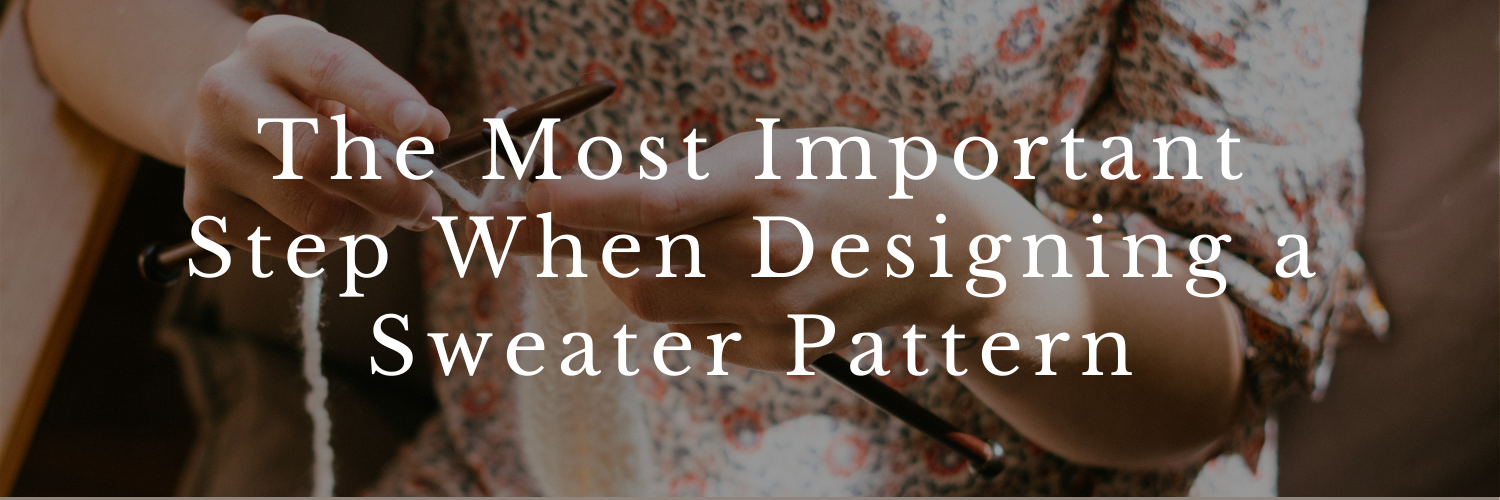The Most Important Step When Designing a Sweater Pattern
So, you want to design your first sweater pattern. But how do you figure out what to do and when? It can be really overwhelming to figure it all out for the first time.
There are lots of steps in the sweater design process, however, there is one very important step that is often overlooked by new designers: understanding your chosen sweater construction.
In this blog post, I’m going to explain why a good understanding of sweater construction is often the missing piece for many new sweater designers, as well as how you can learn more about garment construction to support you in your sweater design journey.
Why Understanding Sweater Construction Matters
Many would-be sweater designers don’t have too much trouble coming up with design ideas, however, they’re completely flummoxed by how they would turn their ideas into an actual sweater pattern.
That’s where you need an understanding of sweater construction.
Without it, you’ll struggle with sketching achievable design ideas, figuring out what garment measurements you need to determine, calculating your shaping and writing your pattern, not to mention the order in which you’ll do all of it!
Once you fully understand how to construct a variety of different sweater styles, you no longer need to worry about how to put your sweater together. Instead, you’ll be using your knowledge of sweater construction to work out all of the finished garment measurements you’ll need to determine, as well as the shaping you’ll need to make.
From there, it’s just a matter of doing the gauge-related math in your spreadsheet to make sure that each of your sweater design’s sizes results in the right dimensions.
And that’s not the only benefit. Right from the outset, you’ll be able to sketch designs that are achievable in “real life”. Many new designers find themselves sketching sweater ideas with seams in the wrong place or shaping that doesn’t make sense in reality. When you know how a sweater is constructed, you can use it as a basis for all of your sketching to make them far more realistic.
Best of all, you’ll be able to start writing knitting patterns with more ease. With your new knowledge of sweater construction, you’ll be able to use it as the “skeleton” of your pattern instructions, drawing on your spreadsheet calculations, step-by-step, to flesh out the actual numbers you need for each size.
How You Can Learn More About Sweater Construction
Now that you understand just how important an understanding of sweater construction is, how can you build up your knowledge of it? There are two main ways that work well and depending on your learning style, one may be more helpful to you than the other.
Theoretical
If you find that you learn well by reading, you might find that reading through your library of sweater patterns will give you a good understanding of how different styles are constructed. As you’re reading through them, write a summary of each construction, step-by-step, that you can refer back to whenever you need it.
You may also find my blog post all about 3 sweater styles you can design from the top down helpful, too. I share my favourite construction methods for drop-shoulder, raglan and set-in sleeve sweaters, categorised by difficulty.
The benefit of this theoretical method is that you can learn quite a lot in a short space of time, which is helpful when you want to work quickly and jump into your own sweater design as soon as possible. However, for many designers, they need to actually do something to understand it properly. Reading it through isn’t enough.
Practical
If you’re like me and learn better by doing, you’re better off knitting from a variety of sweater patterns. As you knit through each pattern, you’ll learn, practically, how it all comes together. Again, it will help if you write summarised notes as you go along about how the garment is constructed so that you can refer to them in the future.
Of course, the downside of this method is that sweater knitting takes a long time, so it’s not as easy to just learn a new construction style! It’s a much bigger investment, both in time and money, but of course, if it’s something you would love to knit and want to wear or gift to a loved one, it is probably an investment you’re willing to make!
A way to speed this process up a little is to knit from children’s patterns, which are smaller and often constructed in similar ways to adult sweaters. My students inside of Sweater Design School actually receive miniature patterns for each pullover construction featured in the course so that they can get a practical understanding of each! Physically constructing a pullover, even a miniature one, can do wonders for your understanding of sweater construction.
Ready to Design Your First Pullover?
If you dream of designing and releasing your very first sweater pattern, I’d love to invite you to my free on-demand workshop, How to Confidently Design Multi-Size Sweater Patterns - Without Worrying About Whether Your Ideas Are Unique Enough to Stand Out Amongst Other Designers.
In this workshop, I’ll be sharing 3 simple strategies you can use to generate countless stand-out sweater design ideas makers will want to knit, even if you are worried you don’t have enough experience or originality.
To grab your free ticket to the workshop, sign up here.



